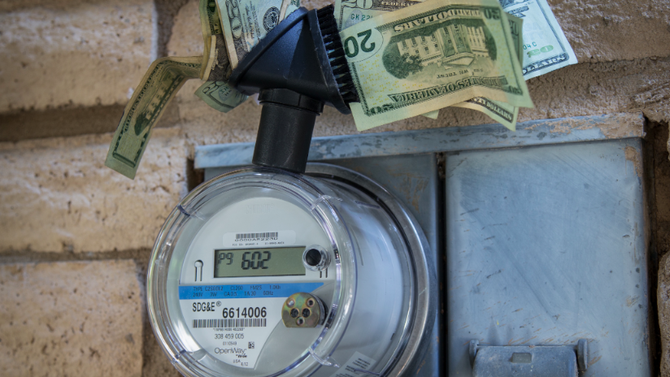 Facebook
Facebook
 X
X
 Instagram
Instagram
 TikTok
TikTok
 Youtube
Youtube

At the Escondido City Council meeting on July 24, Juanita Hayes, one of SDG&E’s public affairs managers, gave a presentation describing her company’s latest rate hike scheduled to be effective September 1.
“If you have a bill where electricity costs you about $100 a month, it will increase $15 [15 percent],” Hayes said. “If your bill is $250 a month, you should expect a $75 increase [30 percent].”
Hayes stated that rates are divided into four tiers based on usage: Tiers 1 and 2, which comprise about 75 percent of their customers, will see no change. If you live inland around Escondido and your electricity bill is normally under $100, your rates will not change.
Residential Tiers 3 and 4 and businesses will bear 100 percent of the cost increase. Currently, that is about 300,000 residential customers and 80,000 businesses. The Tier 3 and 4 residential customers will experience a 15 to 30 percent overall increase, while business customers can look forward to an increase of 11 to 18 percent. Hayes cited numerous reasons for the spike in rates:
● Environmental costs. New state and federal environmental requirements, such as the state mandate to generate 33 percent of electricity via renewable resources by 2020. SDG&E is currently at about 21 percent. In 2002, they were at 1 percent. Stricter laws to restrict greenhouse gas emissions are also coming into play.
● System upgrades. Steel poles replacing wood; adding 150 weather stations to monitor winds and temperatures in high-risk areas; modernization of infrastructure.
● Regulatory proceedings. A 2012 rate case was not resolved until May 2013; increases for two years will be allowed to be incorporated in 2013. SDG&E has been allowed to catch up 18 months of prior rate increases, starting September 1, in addition to 2013’s increase.
At the conclusion of the presentation, councilman Mike Morasco said, “What it boils down to is overregulation, environmental regulations, and mismanagement. What has been done to reduce costs, via either staff, benefits, retirement packages, etcetera? How is it that the burden is passed on to consumers without having a realistic reduction in the way dollars are spent at SDG&E as a whole?”
Hayes replied, “We’ve taken our fleet and converted to hybrids; we set our office thermostats to 78 or 79 degrees. We’re also having a consulting firm to come in to see what we can do without, how we can streamline positions.”
Councilman Ed Gallo asked, “Are the stockholders also sharing in the pain?”
Hayes said, “No, it’s the rate payers.”
Mayor Sam Abed ended the conversation with, “The problem is that they are the only power provider in the state with the PUC’s oversight. We understand it’s a complicated issue, but I don’t think consumers are that upset about an additional $15 on a $100 bill….”
For more information about the rate-hike issue, go to SDG&E’s website.


At the Escondido City Council meeting on July 24, Juanita Hayes, one of SDG&E’s public affairs managers, gave a presentation describing her company’s latest rate hike scheduled to be effective September 1.
“If you have a bill where electricity costs you about $100 a month, it will increase $15 [15 percent],” Hayes said. “If your bill is $250 a month, you should expect a $75 increase [30 percent].”
Hayes stated that rates are divided into four tiers based on usage: Tiers 1 and 2, which comprise about 75 percent of their customers, will see no change. If you live inland around Escondido and your electricity bill is normally under $100, your rates will not change.
Residential Tiers 3 and 4 and businesses will bear 100 percent of the cost increase. Currently, that is about 300,000 residential customers and 80,000 businesses. The Tier 3 and 4 residential customers will experience a 15 to 30 percent overall increase, while business customers can look forward to an increase of 11 to 18 percent. Hayes cited numerous reasons for the spike in rates:
● Environmental costs. New state and federal environmental requirements, such as the state mandate to generate 33 percent of electricity via renewable resources by 2020. SDG&E is currently at about 21 percent. In 2002, they were at 1 percent. Stricter laws to restrict greenhouse gas emissions are also coming into play.
● System upgrades. Steel poles replacing wood; adding 150 weather stations to monitor winds and temperatures in high-risk areas; modernization of infrastructure.
● Regulatory proceedings. A 2012 rate case was not resolved until May 2013; increases for two years will be allowed to be incorporated in 2013. SDG&E has been allowed to catch up 18 months of prior rate increases, starting September 1, in addition to 2013’s increase.
At the conclusion of the presentation, councilman Mike Morasco said, “What it boils down to is overregulation, environmental regulations, and mismanagement. What has been done to reduce costs, via either staff, benefits, retirement packages, etcetera? How is it that the burden is passed on to consumers without having a realistic reduction in the way dollars are spent at SDG&E as a whole?”
Hayes replied, “We’ve taken our fleet and converted to hybrids; we set our office thermostats to 78 or 79 degrees. We’re also having a consulting firm to come in to see what we can do without, how we can streamline positions.”
Councilman Ed Gallo asked, “Are the stockholders also sharing in the pain?”
Hayes said, “No, it’s the rate payers.”
Mayor Sam Abed ended the conversation with, “The problem is that they are the only power provider in the state with the PUC’s oversight. We understand it’s a complicated issue, but I don’t think consumers are that upset about an additional $15 on a $100 bill….”
For more information about the rate-hike issue, go to SDG&E’s website.
Comments